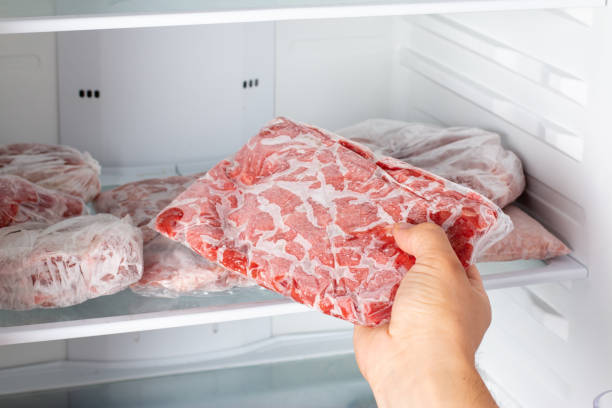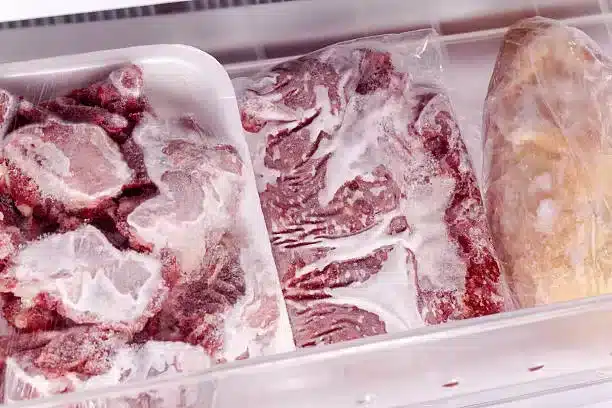If you are a meat lover, you might have considered buying beef in bulk from a local farmer or butcher. Buying beef in bulk can save you money, support local businesses, and ensure high-quality and fresh meat. However, buying beef in bulk also requires some planning and preparation, especially when it comes to storing the meat in your freezer. How much freezer space do you need for 1/4 cow? How do you organize and pack the meat in your freezer? And how long can you store the meat in your freezer? In this post, we’ll answer these questions and give you some tips on how to calculate the perfect space for 1/4 cow in your freezer.
The amount of freezer space you need for 1/4 cow depends on the weight and cut of the meat, but generally, you should expect to need about 4 to 5 cubic feet of freezer space. You should also use proper packaging materials, labels, and inventory methods to store the meat in your freezer safely and efficiently.
How Much Freezer Space Do You Need for 1/4 Cow?
The amount of freezer space you need for 1/4 cow depends on several factors, such as:
- The weight of the cow: The weight of the cow before slaughter is called the live weight, and it can vary depending on the breed, age, and condition of the cow. The average live weight of a beef cow is about 1200 pounds. However, not all of this weight is edible meat. After slaughter, the cow is processed into different cuts of meat, bones, organs, fat, and waste. The weight of the meat after processing is called the hanging weight or carcass weight, and it is usually about 60% of the live weight. The average hanging weight of a beef cow is about 720 pounds. However, not all of this weight is packaged meat. After trimming off excess fat and bones, and grinding some percentage of the meat, the weight of the meat after packaging is called the cut weight or take-home weight, and it is usually about 65% of the hanging weight. The average cut weight of a beef cow is about 468 pounds.
- The cut of the meat: The cut of the meat refers to how the meat is divided into different parts, such as steaks, roasts, ribs, ground beef, etc. The cut of the meat affects how much space it takes up in your freezer, as some cuts are thicker or larger than others. For example, a ribeye steak will take up more space than a sirloin steak, and a chuck roast will take up more space than a tenderloin roast. The cut of the meat also affects how much meat you get from each part of the cow. For example, you will get more meat from the hindquarter than from the forequarter, and more meat from the loin than from the brisket. The cut of the meat can vary depending on your preferences and requests to your farmer or butcher. However, a typical breakdown of a beef cow into different cuts is as follows:
| Part |
Percentage |
Cut |
| Hindquarter |
40% |
Round steak, sirloin steak, tenderloin steak/filet mignon, T-bone steak/porterhouse steak |
| Loin |
20% |
Ribeye steak/delmonico steak/prime rib roast |
| Forequarter |
40% |
Chuck roast/arm roast/cross rib roast/blade roast/boneless chuck roast/flat iron steak/chuck eye steak/chuck short ribs/chuck tender steak/boneless stew beef/cubed steak/ground chuck |
| Brisket |
5% |
Brisket |
| Flank |
5% |
Flank steak/skirt steak/london broil |
| Shank |
5% |
Shank |
| Plate |
5% |
Short ribs/hanger steak |
- The packaging materials: The packaging materials refer to how the meat is wrapped or sealed before storing it in your freezer. The packaging materials affect how much space the meat takes up in your freezer, as some materials are thicker or bulkier than others. For example, vacuum-sealed bags will take up less space than butcher paper or plastic wrap. The packaging materials also affect how long the meat lasts in your freezer, as some materials are more effective at preventing freezer burn or moisture loss than others. For example, vacuum-sealed bags will last longer than butcher paper or plastic wrap. The packaging materials can vary depending on your preferences and requests to your farmer or butcher. However, some common packaging materials are:
| Material |
Description |
Pros |
Cons |
| Vacuum-sealed bags |
Plastic bags that remove all air from inside and seal tightly around the meat |
Prevent freezer burn and moisture loss, take up less space, last longer |
More expensive, require special equipment |
| Butcher paper |
Thick paper that is coated with wax or plastic on one side and wrapped tightly around the meat |
Prevent freezer burn and moisture loss, easy to label, inexpensive |
Take up more space, last shorter |
| Plastic wrap |
Thin plastic film that is wrapped loosely around the meat |
Easy to use, inexpensive |
Allow freezer burn and moisture loss, take up more space, last shorter |
Based on these factors, the amount of freezer space you need for 1/4 cow can vary, but generally, you should expect to need about 4 to 5 cubic feet of freezer space. This is equivalent to a small chest freezer or a medium upright freezer. To calculate the exact amount of freezer space you need for 1/4 cow, you can use this formula:
Freezer space (cubic feet) = Cut weight (pounds) / 35
For example, if your cut weight is 120 pounds, you will need:
Freezer space (cubic feet) = 120 / 35 Freezer space (cubic feet) = 3.43

How to Store Meat in Your Freezer
Once you have determined how much freezer space you need for 1/4 cow, you need to store the meat in your freezer safely and efficiently. You should follow some steps to store meat in your freezer properly:
- Organize your meat by category, date, or frequency of use. You should group your meat into categories such as steaks, roasts, ribs, ground beef, etc. You should also arrange your meat by date of purchase or expiration date, placing the oldest items in front or on top of the newer ones. Alternatively, you can organize your meat by frequency of use, placing the most frequently used items in front or on top of the less frequently used ones.
- Label your packages with the name and date of the meat. You should use a permanent marker or a sticker to write the name and date of the meat on each package. This will help you identify and rotate your meat more easily and avoid wasting food.
- Keep an inventory of your meat and update it regularly. You should use a notebook, a spreadsheet, or an app to keep track of what you have in your freezer, how much, and when you bought or cooked it. You should update your inventory every time you add or remove something from your freezer and check it periodically to see what you need to use or buy. This will help you avoid overstocking, understocking, or forgetting about your meat.
- Maintain a constant temperature in your freezer. You should keep your freezer at 0°F or below, which is the ideal temperature for frozen food safety and quality. You should also avoid opening your freezer too frequently or leaving it open too long, as this can cause temperature fluctuations and ice buildup. You should also check your freezer regularly for any signs of malfunction or power outage.

How Long Can You Store Meat in Your Freezer?
The shelf life of meat in your freezer depends on several factors, such as the type and cut of the meat, the packaging materials, and the temperature and condition of your freezer. However, as a general guideline, you can refer to this chart for the approximate shelf life of different types of meat in your freezer:
| Type |
Cut |
Shelf Life |
| Beef |
Steaks |
6 to 12 months |
| Beef |
Roasts |
4 to 12 months |
| Beef |
Ribs |
6 to 12 months |
| Beef |
Ground beef |
3 to 4 months |
| Beef |
Brisket |
6 to 12 months |
| Beef |
Flank steak/skirt steak/london broil |
6 to 12 months |
| Beef |
Shank |
4 to 12 months |
| Pork |
Chops |
4 to 6 months |
| Pork |
Roasts |
4 to 12 months |
| Pork |
Ribs |
4 to 6 months |
| Pork |
Ground pork/sausage/bacon/ham |
1 to 2 months |

To ensure the best quality and safety of your frozen meat, you should follow these tips:
- Use proper packaging materials that prevent freezer burn and moisture loss
- Label your packages with the name and date of the meat
- Rotate your meat regularly and use the oldest items first
- Thaw your meat safely in the refrigerator, in cold water, or in the microwave
- Cook or eat your meat within 24 hours of thawing it
- Do not refreeze your meat after thawing it




